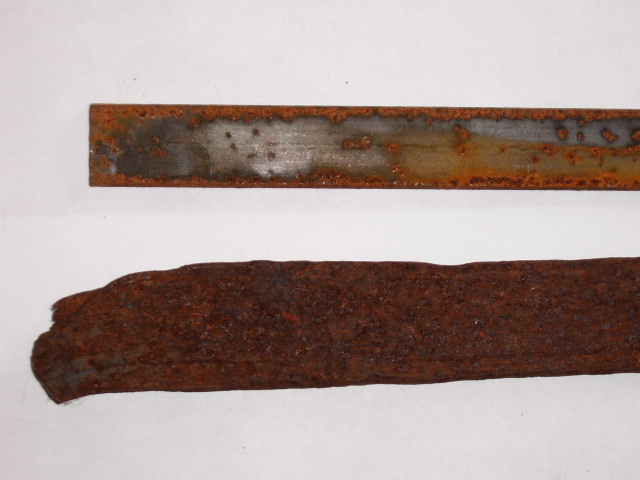Wrought iron
Contents |
[edit] What is wrought iron?
Wrought iron is a very low carbon metal made by intensive hand work using small scale production methods. Predominantly, it was manufactured prior to the Patent for the Bessemer process in 1856.
There were numerous methods for producing wrought iron; early iron is often referred to as Charcoal iron, or Bloomery iron, because it was produced in small blooms. In the late 18th century more efficient Puddling furnaces were used to produce Puddled wrought iron. Many other types of production methods were used across the world, all of which produced varying qualities and quantities of iron.
Confusingly, the term 'wrought iron' can also be applied to decorative hand made steel artefacts because wrought means to make by hand (to wrought). However, a more generally accepted description for these hand made steel items is decorative ironwork.
[edit] Identifying wrought iron
There are four ways in which wrought iron can be identified by using a comparison method:
- Run a file across the iron to see if it cuts easily, do the same to a piece of steel to compare the resistance on the file.
- Using a grinder to observe the spark pattern between the steel and iron; the latter will produce a heavier brighter spark; higher carbon steels will produce a fine duller spark.
- Hold the top of the bar and gently tap it; wrought iron will have a dead sound and steel will ring. high carbon steels will have an even higher ring to them.
- Observe the structure, if it has a wood like grain to it then it is likely to be charcoal iron, however, Puddled wrought iron appears more homoginised like mild steel.
Microscopic analysis will more accurately determine if the metal is iron or steel.
[edit] The difference in performance and character between wrought iron and steel
Clearly there are visual differences between steel and early wrought iron due to the wood grain effect of the latter. Wrought iron from all periods, and production methods, could take on the same appearance as mild steel if it was repeatedly worked to refine it; furthermore, once painted the visual differences are less apparent to the naked eye.
The structural performance of wrought iron cannot be compared with mild steel, despite the 1938 British Standards (BS 762-1938) because, without reliable records, there is no definitive way of knowing the provenance of the specific wrought iron as found. Analysis from Brunell's iron ship SS Great Britain 1843, by Dr R. Walker in 2002 showed that the mechanical properties were '..considerably poorer than those tolerated for mild steel.'
Corrosion resistance was investigated in 1952 by Chilton and Evans who concluded that even the very best quality wrought iron had not shown '...phenomenally good resistance to corrosion.' earlier investigations by the Hudson Corrosion Committee reported similar findings. There is some evidence that the presence of nickel in the iron ore when smelted, may have an influence over corrosion resistance; ores from Sweden and Greece tended to contain higher levels of nickel in the iron ore (Tylcote 1972) and showed barriers to corrosion.
[edit] Conservation of wrought iron
Methods for cleaning and re-coating wrought iron must first be carefully considered. Aggressive forms of cleaning and inappropriate coatings can contribute to further accelerated corrosion. Cardiff University are examining the effects of cleaning and re-coating http://orca.cf.ac.uk/61280/1/Emmerson%20and%20Watkinson_Metal%202013.pdf
This enquiry should inform decisions regarding the most appropriate methods for the longevity of exposed ironwork.
Corrosion generally takes place at the crevices where the iron is joined. Crevices tend to put stresses on the coating at these junctions causing water to ingress and be trapped, sometimes by the coating itself. Current thinking advises the use of flexible or mobile protective coating to accommodate this expansive action.
In some cases it may be beneficial to control corrosion rather than attempting to stop it. Cardiff University has been contributing to the conservation methods used to preserve Brunel's SS Great Britain using one such method. http://www.cardiff.ac.uk/share/research/projectreports/ssgreatbritain/index.html
[edit] Availability of wrought iron and alternatives for consideration
Wrought iron is still available as recycled iron; the last production of virgin wrought iron from iron ore was in 1974. Good conservation will consider repairs in wrought iron, mild steel, weathering steel (CORTEN), pure iron and other ferrous and non-ferrous metals. The specification should be informed by an experienced professional who can explore all the options and provide good justification for the choice.
The potential for bi-metallic corrosion should always be checked before using dissimilar metals. https://en.wikipedia.org/wiki/Galvanic_corrosion
[edit] Organisations
For practical assistance and advice the following organisations can be contacted:
- The British Artist Blacksmiths Association (BABA)
- Victoria and Albert Museum
- Historical Metallurgy Society
- The Worshipful Company of Blacksmiths
- National Heritage Ironwork Group (NHIG)
- Hereford and Ludlow College
- The National Directory of Blacksmiths.
See also: Wrought iron, yesterday and today.
[edit] Related articles on Designing Buildings
- Cast iron.
- Clifton Suspension Bridge.
- Concrete vs. steel.
- Conservation of Architectural Ironwork.
- Corrosion resistance.
- Difference between cast iron and wrought iron.
- Ferrous.
- Investment casting.
- Iron.
- Ironwork.
- Metal.
- Qualities Needed for Stainless Steel Suppliers.
- Stainless steel.
- Steel.
- Steel construction floor vibration.
- The iron roof at the Albert Dock.
- Types of metal.
- Weathering steel.
- Wrought iron, yesterday and today.
IHBC NewsBlog
Heritage Building Retrofit Toolkit developed by City of London and Purcell
The toolkit is designed to provide clear and actionable guidance for owners, occupiers and caretakers of historic and listed buildings.
70 countries sign Declaration de Chaillot at Buildings & Climate Global Forum
The declaration is a foundational document enabling progress towards a ‘rapid, fair, and effective transition of the buildings sector’
Bookings open for IHBC Annual School 12-15 June 2024
Theme: Place and Building Care - Finance, Policy and People in Conservation Practice
Rare Sliding Canal Bridge in the UK gets a Major Update
A moveable rail bridge over the Stainforth and Keadby Canal in the Midlands in England has been completely overhauled.
'Restoration and Renewal: Developing the strategic case' Published
The House of Commons Library has published the research briefing, outlining the different options for the Palace of Westminster.
Brum’s Broad Street skyscraper plans approved with unusual rule for residents
A report by a council officer says that the development would provide for a mix of accommodation in a ‘high quality, secure environment...
English Housing Survey 2022 to 2023
Initial findings from the English Housing Survey 2022 to 2023 have been published.
Audit Wales research report: Sustainable development?
A new report from Audit Wales examines how Welsh Councils are supporting repurposing and regeneration of vacant properties and brownfield sites.
New Guidance Launched on ‘Understanding Special Historic Interest in Listing’
Historic England (HE) has published this guidance to help people better understand special historic interest, one of the two main criteria used to decide whether a building can be listed or not.
"Conservation Professional Practice Principles" to be updated by IHBC, HTVF, CV
IHBC, HTVF, and CV look to renew this cross-sector statement on practice principles for specialists working in built and historic environment conservation roles.


















Comments
An excellent and informative entry on wrought iron, thank you.